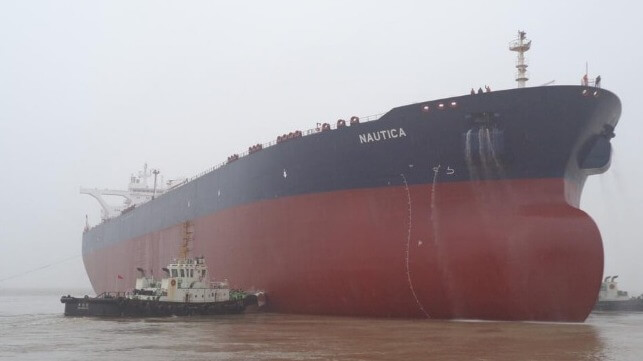Euronav Tanker Departs for Yemen to Replace Decaying FSO Safer

Euronav’s VLCC tanker the Nautica has departed for Yemen in the first step toward transferring the oil stored aboard the decaying FSO Safer to a new storage arrangement. UN officials are calling the tanker's departure a key step while however cautioning that they still need to raise a significant amount of money to complete the first, emergency phase of the operation.
Euronav and the UN Development Program reached an agreement at the beginning of March for the acquisition of the VLCC and for Euronav’s assistance in the effort to complete the transfer of more than one million barrels of oil from the Safer to the new tanker.
The Nautica is a 15-year old VLCC built in China and is 307,000 dwt. She entered service in 2008 as the Maersk Nautica and was acquired by Euronav in 2014. The vessel is 1,055 feet long and currently registered in Liberia.
The tanker was drydocked in Zhoushan, China where she has been since early March. She underwent regular maintenance as well as some necessary modification for her new assignment. The Nautica departed China today, April 5, and is currently sailing to Singapore where she is scheduled to make a stopover on April 15. UN officials are saying the tanker is expected to arrive in Yemen in early May.
“The departure of the Nautica, and its onward journey to the Red Sea, is a significant next step in the complex operation to take on the oil from the Safer. This moment marks the culmination of many months of preparation and coordination,” said Achim Steiner, UNDP Administrator.
A team from SMIT has begun preliminary work and planning for the operation. They were to survey the Safer and prepare the vessel for the operation. The Safer (406,639 dwt) was built as a supertanker in 1976 and converted a decade later to be a floating storage and offloading facility moored about 4.8 nautical miles off the coast of Yemen. The vessel holds an estimated 1.14 million barrels of light crude oil.
Production, offloading, and maintenance operations on the Safer were suspended in 2015 because of the war in Yemen. Maintenance was continued by a skeleton crew with limited resources with the UN reporting that the Safer’s structural integrity has significantly deteriorated. It is believed the tanks have not been properly ventilated since 2017. Assessments indicate that the vessel is beyond repair.
Announcing the agreement with the UN, Hugo De Stoop, CEO of Euronav said the company was proud to be a part of the effort and committed to providing the necessary expertise with its operational staff to support the salvage procedure. “This critical operation requires dedicated support from Euronav for at least nine months and reflects our wider sustainability and environmental credentials,” he said.
The emergency phase of the plan, which is currently underway, called for stabilizing the Safer and preparing it for the transfer. As well as preparing it to be towed away. The second phase of the UN plan calls for the installation of a catenary anchor leg mooring (CALM) buoy to which the replacement VLCC will be connected as a safe, long-term replacement, and the towing and scrapping of the Safer.
“The sailing of the vessel that will take on the Safer’s oil brings us closer to preventing a catastrophe,” said David Gressly, the UN Resident and Humanitarian Coordinator for Yemen, who has led the UN efforts since September 2021. “We have the best available technical expertise and political support from all sides. Donors have been generous. We just need the final piece of funding this month to ensure success.”

that matters most
Get the latest maritime news delivered to your inbox daily.
UNDP officials highlight that the war in Ukraine and changes in the oil market drove up the estimated cost of the replacement tanker. As outlined in the UN’s initial plan in April 2022, the budget for the two-track operation was $144 million, with current reports saying they will now need $129 million for the first phase. As of the beginning of April, the UN reports commitments for $95 million with efforts continuing to cover the gap of $34 million. The private sector provided $12 million with another $200,0000 from individuals with the majority coming from UN member states.
To fill the budget gap, the UN is appealing to member states and private entities, and the global public through a crowdfunding appeal. They are also exploring internal means of temporarily covering the budget shortfall while the fundraising continues.
